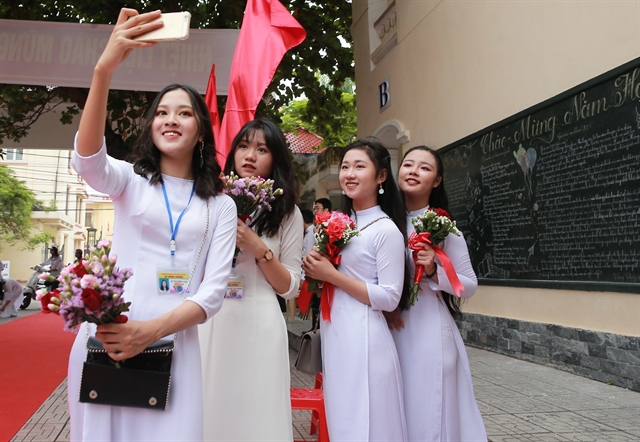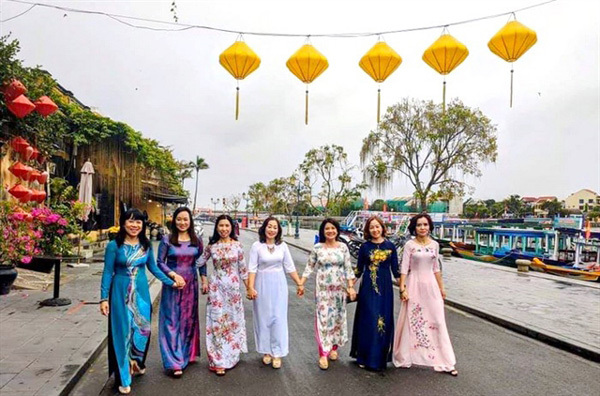 |
|
Traditional áo dài for both men and women are the dress code for all engagement ceremonies.
|
This week leading up to International Women's Day tomorrow, Việt Nam's Women's Union has appealed to all women in the country to wear their áo dài, be proud of their common heritage and protect it together.
I must admit I am an áo dài (traditional long dress) fan. I wish every Vietnamese woman, young or old, had at least one.
The áo dài as the world knows it today was designed by artist Cát Tường, better known by his pen name Le Mur, in the 1930s. Trained at the Indochinese School of Fine Arts, Le Mur, together with other avant-garde artists called on people to discard old habits and backward customs to relieve themselves from the heavy burden of tradition and cliched thinking.
"Clothes are for covering your bodies, but they are the mirror that reflects the level of understanding, the intellectual capacity of a country" was their motto.
 |
|
A group wedding for less advantaged couplesin the city. The local chapter of the Trade Union made sure they had theproper attire, a party and registered at City Hall.
|
Traditional Vietnamese long robes usually consist of a few layers. They are quite a burden to wear, and the sober brown colour makes them quite monotone.
The Le Mur áo dài added western cuts to the long robes and he gave the colours more nuances and shades, making the women look much younger, more dynamic and fresher, rather than quiet, obedient and a shade of herself.
During the long years of war and a divided country, the áo dài was more commonly worn in the south than the north from 1945 to 1975. The ladies of Sài Gòn in 1970 sported various styles of áo dài with a tiny waist and shorter front and back flaps.
To make it more comfortable in the hot summers of the south, Trần Lệ Xuân (better known as Madame Nhu), a Hà Nội native, created her own heart-shaped collar for the áo dài. It was criticised at first as being too open, but the style still has followers across the country now.
 |
|
High school girlsall wearing white áo dài.Itmakes for a beautiful scene and leaves them with good memories of this school in Nam Định Province.
|
Calling upon all women to wear an áo dài on Women's Day, the Women's Union says they hope all women will treasure their common heritage, and as a result, preserve their culture.
Áo dài is important for important milestones in a woman's life: it is a school uniform for all high school girls, it's worn for an engagement ceremony, for Tết and later for her children's ceremonies. Teachers wear them for school opening and closing days, for Vietnamese and International Women's Days, as well as on Teachers' Day.
Female politicians wear them for international events and last but not least, spouses of the President, Prime Minister and Government ministers all wear them on official State visits abroad or for hosting State banquets for National Day celebrations.
 |
|
Today the áo dài is no longer part of the daily wardrobe, but on a good day in a garden or park, you will find groups of women, young and old, posing for photos next to old walls or bythe ancient city's citadel. — Photo courtesy of Cộng Studio
|
All áo dài-clad ladies look graceful in their long silhouettes but beware, they work, they teach, they negotiate and make business deals as well as their male counterpart.
Do not let the look mislead you! Let the true spirit of Women's Day spread across Việt Nam with graceful, strong, decision-making and responsible women in charge. — VNS
Nguyen My Ha

Vietnamese women encouraged to wear ao dai for week-long cultural event
Vietnamese women are urged to wear áo dài (traditional dress) from March 2-8 as part of a national event titled “Áo dài - Di sản văn hóa Việt Nam” (Áo dài-Vietnamese Cutural Heritage) being held across the country.

Traditional ao dai in the spotlight
The Vietnamese Women’s Museum is hosting a spring celebration inspired by áo dài (traditional long dress) and flowers, including a fashion show, exhibition and other activities honouring traditional cultural values.
 This week leading up to International Women's Day tomorrow, VN Women's Union has appealed to all women in the country to wear their áo dài, be proud of their common heritage and protect it together.
This week leading up to International Women's Day tomorrow, VN Women's Union has appealed to all women in the country to wear their áo dài, be proud of their common heritage and protect it together.